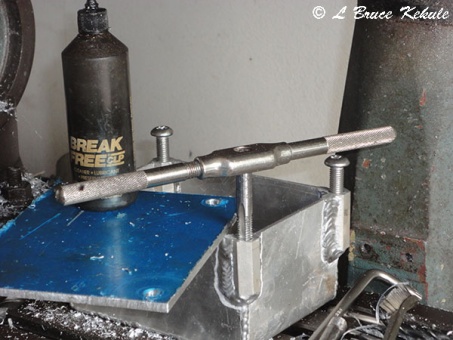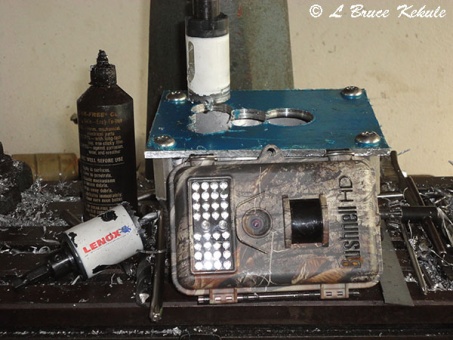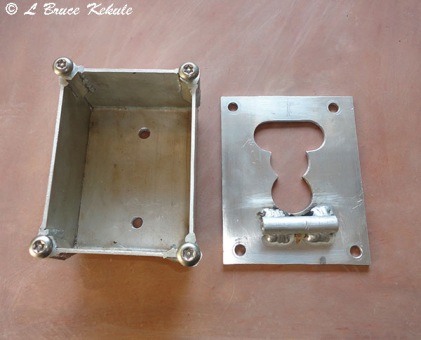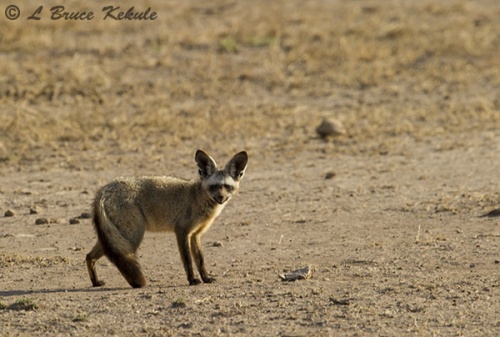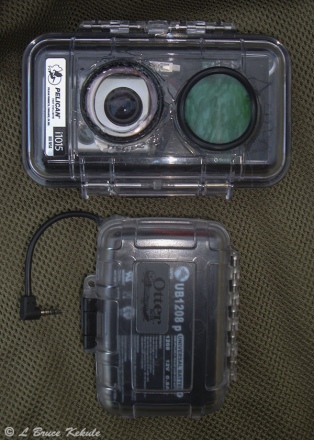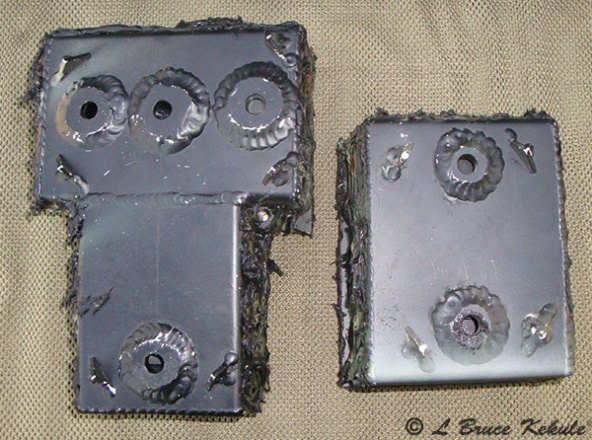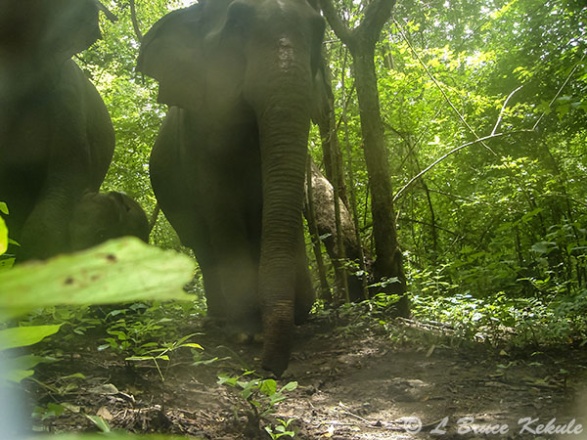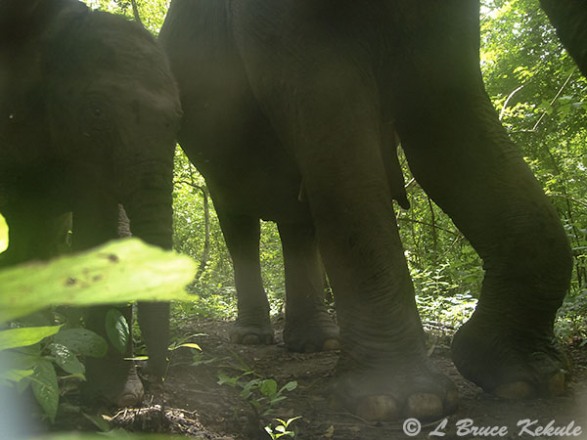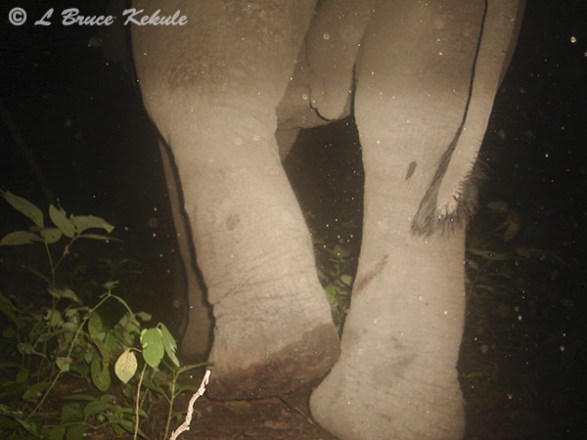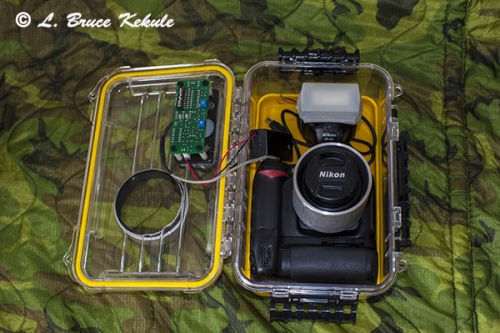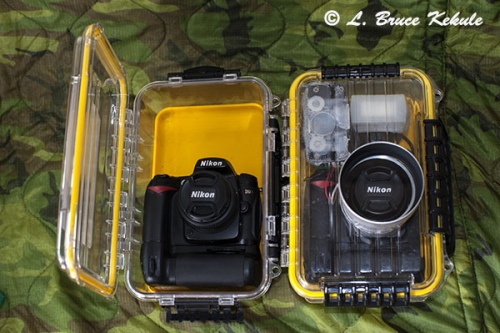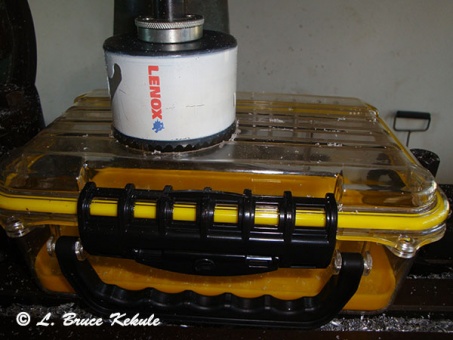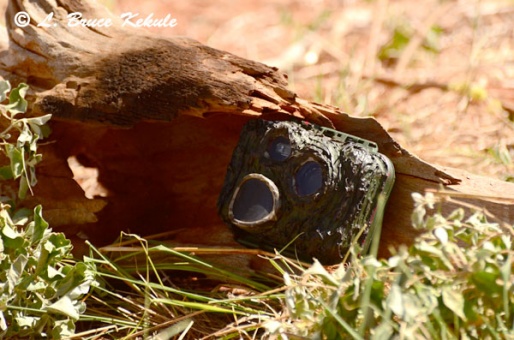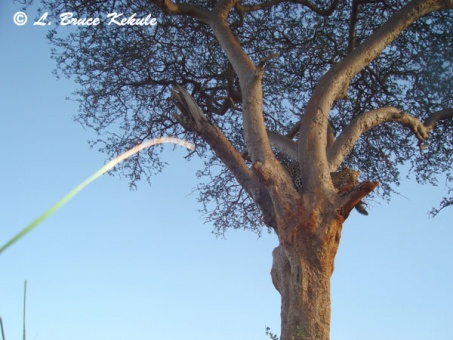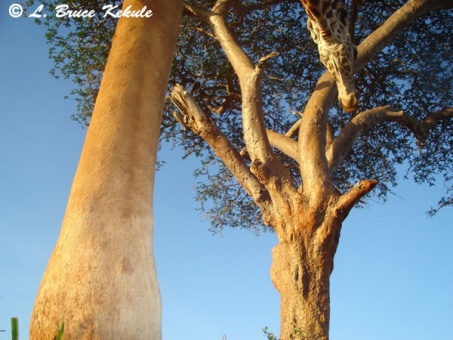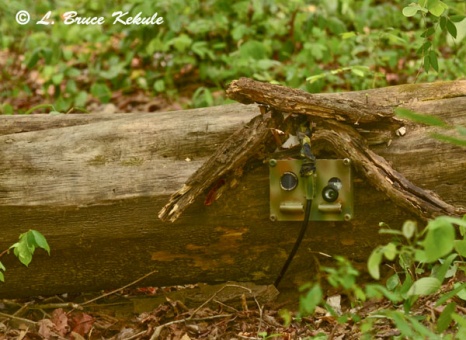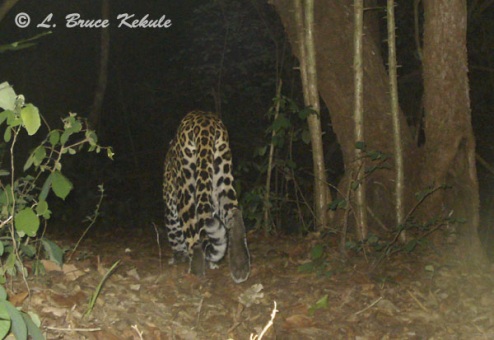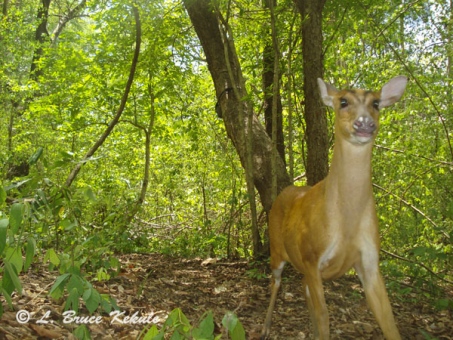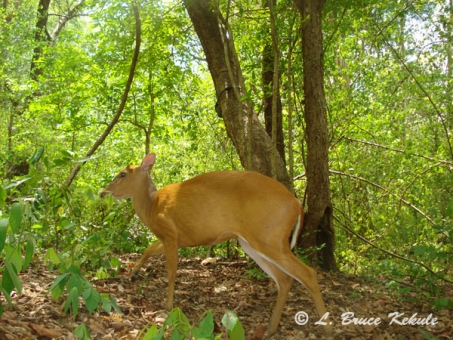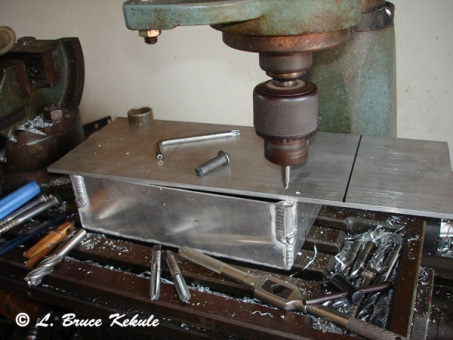Posts Tagged ‘camera-trap’
‘Two ‘elephant-proof’ boxes
Custom made protective boxes for my Bushnell Trophy Cams
Finished boxes for my HD Bushnell Trophy Cams.
After using a couple commercial protective boxes with thin steel sheet metal and getting them bashed in by elephants, I thought it was about time to make-up some of my tough aluminum ‘elephant-proof ‘ boxes for my two 2012 HD Bushnell Trophy Cams. These are great little cams and I use mine exclusively on video as the HD clips are quite good but the photos only fair.
Tapping the 10mm threads.
First off, I got my welder to construct two boxes from 3mm thick plate aluminum and had him weld in some 1-1/2″ long aluminum octagon dowels in each corner. These would except 10mm ‘power torque’ machine screws. I machined the boxes flat and drilled and tapped the corners. The 6mm thick faceplate was installed and milled out for the sensor, lens and LEDs, plus a 10mm hole at the bottom for the mic.
Boring out the faceplate for the sensor.
Boring out the faceplate for the LEDs.
Milling out excess.
These boxes use two 3/8″ x 3″ stainless steel lag bolts from the inside for securing the box to the tree before putting the cam in and securing the faceplate. This alone keeps elephants at bay. The back is beefed-up with heavy duty plate and what I call ‘shark teeth’. A ‘Python’ locking cable is also installed for back-up.
Finished box in the raw.
These boxes have stood the test of time….! All my cams use this system. The tremendous power of Asia’s largest land mammal is nothing to sneeze at. They can tear them off the tree if only a cable is used. My close friend and fellow wildlife photographer, Paul Whitehead has lost quite a few cams already over in the East using only cables.
Back-end showing beefed-up holes and ‘shark teeth’.
Needless to say, I’m confident when I leave my cams in ‘elephant country’ using this system. Tomorrow I leave for the forest to set-up these two Bushnell’s in a new location in Huai Kha Khaeng, Thailand’s premier tiger country. I am hopeful that loads of good video footage will be forthcoming. Hope this helps those with elephant or bear problems. A welding and machine shop is of course needed for this job…! Good luck.
Newly finished box next to an older one.
Africa Series: Sony S40 catches bat-eared fox
A camera trap’s final stint at a fox den in Amboseli National Park, southern Kenya
Bat-eared fox cub in its den
I took a Sony S40/Plano 1449/SSII/4 double AA externals to southern Kenya in December 2012 to be used in quick set-ups with minimum security (no Python locking cable) mainly to be used by the side of the road. The first location was Amboseli National Park near Mount Kilimanjaro where I captured a rare carnivore: a whole den of bat-eared foxes.
Bat-eared fox adult just outside its den
As me and my driver/guide Patrick Njoroge were on game drive, we noticed two adult foxes running away from their den that was about 10 feet from the road. I got some nice shots of the adults in great light. I decided to leave the cam overnight in some rocks near the ground as the site looked promising.
The other mature fox in the afternoon
While setting up the cam, I heard the pups in the den and one of them actually barked at me. I sat in the truck and waited, and in a few minutes a young one popped its head out shown in the lead photo. I had a great time shooting the little carnivore with my Nikon D3s/600mm.
Fox family checking out the S40
We left shortly thereafter so as not to disturb them and let the home-brew do its work. That night, two adults and four cubs were caught by the S40. The next morning I was elated to see that this family was surviving in Amboseli. I downloaded everything from the card immediately. It’s a good thing I did too…!
Getting closer and not afraid of the flash
Later that day we moved to Tsavo West National Park situated east where I previously had set-up a Bushnell Trophy Cam at a waterhole deep in the park. With no cable, the S40 attached with tape was vulnerable but I thought who would steal a cam way out here. Boy, was that ever a big mistake. That night, a hyena came and took the S40, and the Bushnell recorded it all as seen on my previous post ‘Bad Hyena Night’.
Even the cubs are not afraid
It’s hard to believe an African hyena would actually take my cam. Somehow, the creature must have been attracted to the salt residue left by my hands is the only explanation I have. The next morning on our way out, we looked around but could not find it. We left but I accepted the fact the S40 was gone but it had done a brilliant job of catching the foxes and that was that…!
My favorite S40 shot
I wonder where the S40 is now? Could it be down the hyenas den still tripping? Is it a chew-thing for the hyena cubs? I will never know.
Sony S40 camera trap set in rocks by the road at bat-eared fox den
The moral of this story; whenever you can, always download your card or you could loose a lot….!
Enjoy.
Bad Hyena Night
This is what happens when you get lax….or was it just an oversight…? Needless to say, I lost my great little Sony S40 cam in a Plano 1449 and SSII with double AA externals to some tenacious hyenas. It was a great little cam and took good photos. And yes, it was the S40 hacked by Joe 12-Ringer I won in last year’s camera trap competition held by Camtrapper.com. I took this homebrew to Kenya as a quick-setup cam mainly to be used by the side of the road and hence, there was no ‘Python’ locking cable. Unfortunately, I also lost a whole bunch of photos that the cam took because I used some sticky tape to hold it in position above a Bushnell Trophy Cam. The rest is history.
PS: I do have two spare S40s with boxes and sensor boards that will be built some time in the near future. They are great little cams…!
Go Pro trail cam – Bushnell companion cam
Homebrew video trail camera and commercial back-up:
Early this year, I acquired a Go Pro Hero 2 wanting to build a daytime HD video cam for a certain tree and a long soak at my favorite workplace; Huai Kha Khaeng Wildlife Sanctuary in Western Thailand.
I also had a 2011 Bushnell Trophy Cam ‘Bone Collector’ that takes quite decent IR clips, and would set it up next to the Go Pro. The Bushnell could also be used as a security cam set to video watching over the Go Pro from a hidden position.
Visited by tiger and leopard, a huge tree at a mineral deposit deep in the forest is perfect for these cams. A myriad of other species also come down to this waterhole during the daytime like wild cattle, bears and deer, and is a sure bet for some good videos, specially during the dry season coming up.
The first order of business was what case would I use. While shopping at an outdoor supply company, I found a unique Pelican i1015 meant for an iPhone or iPod with a stereo plug inside the case with an external jack. The Go Pro and SSII board fit with room to spare. A 40.5mm UV filter and HPWA lens are attached to the case with ‘Goop’.
I also wanted an external power source and picked up a 12v SLA #UB1208p battery that fits perfectly in an Otter 1000 case. Being modular would allow different external power supplies to be used. I cut the wire in the i1015 and attached it with ‘Goop’ to the battery case. Alternative externals can be 3 18650 4.2v lithiums.
In the meantime, I sent the camera to fellow Camtrapper.com member ‘TRLcam’ to be hacked, and then visited Gary at Snapshotsniper in Oklahoma where I purchased a few of his excellent SSII boards programmed for the Go Pro.
After consultations with TRL, a 12v to 5v USB adapter was used as the easiest way to connect the 12v battery to the Go Pro.
Everything was put together and I made up an ‘elephant proof’ aluminum box with 8mm ‘power torque’ machine screws designed for the Pelican in the horizontal position, and the Otter in the vertical position. Another box was built for the Bushnell.
3D camo is made up using industrial black silicon sealant and painted with several shades of camouflage in khaki, green and brown using bamboo leaves. Simple but effective.
Security will be four 3/8” X 3” stainless lag bolts and two ‘Python’ 3/8″ locking cables for the Go Pro, and two lags and two 5/16″ cables for the Bushnell.
Both cams will be set in a week or so, and ‘setup’ and videos will be forthcoming.
I would like to thank TRLcam for his help and advice, and to Gary for the boards.
Hope this helps those interested in building a Go Pro. I might make-up an IR unit at a later date to work in parallel with this one but will have to study the components and plans first. They certainly are great little cameras…!
UPDATE:
The Go Pro attached to the Snapshotsniper SSII board will not work without the following modification:
A PN2222 resistor and a 10K transistor installed as shown is required to control the Go Pro.
A wild elephant’s foot…!
All images by a Sony S600/S40 camera trap
Wild Asian elephant herd checking out my camera trap
The toughest test of a camera trap in Thailand’s forest is being attacked by the awesome power of a wildlife elephant. These huge beast are very inquisitive and will check-out anything that catches their eye. Camera traps are of special interest and depending on how tight the cam is on the tree, these giants will try to rip it off. The following sequence was captured last month.
Mother elephant and baby
Elephant’s rear end
Female elephant showing tushes
Elephant’s muddy foot
Another ‘mud paw’
They tried in vain to get my cam off but it was so low, they could not get any leverage so they just used their muddy ‘paws’ but failed. However, the lens and sensor were covered in mud after this. The last few shots show what an elephant’s foot looks like…!
Special interest:
This shot of a very old, old banteng bull with a damaged pair of testicles was earlier on the same setup before the elephants. No telling what happened to this poor guy. He was probably evading a predator and scratched em’ on a stick while bolting through the forest. There are big tigers here that go after the old bulls…!
This bull is very old judging from the hang on the dang….!
LBK ‘Clear-view’ Nikon DSLR camera trap
Nikon N90s/Nikon SB400/Plano 1460/ Yeticam sensor board
A new DSLR homebrew camera trap in the make-up phase
When I began shooting wildlife with a camera some 16 years ago, I chose Nikon because of several reasons but rugged camera bodies and great lenses were the main factor. I’ve always been partial to this brand. However, after horrible Nikon service here in Thailand run by a local tyrant, I switched to the Minolta brand in film and then Konica-Minolta in digital. After they went belly-up, I went back to Nikon and fortunately the mother company from Japan is now running things here in Thailand including excellent service.
I picked up two D90s that is reasonable in price and very good for quality images. A couple of generic battery packs were purchased and use two Nikon EN-EL3e lithium batteries in each. I had some old ‘Yeti’ boards and ordered two “EOS” chips from Mark over at Yeticam.com. This is my first homebrew DSLR using a Nikon and I chose a 50mm lens for this rig. With a 1.5-factor, the lens is comparable to a 75mm that is OK for frame filling shots that I prefer for camera trap images.
Both units ready to be completed
While in the States recently, I found some Plano ‘Guide Series’ # 1460 cases at Dick’s Sporting Goods up in New York that looked perfect for a DSLR cam. I bought two in clear as my plan for this cam was to use a small Nikon SB-400 flash shooting straight through the case and activating some remote slaves. A flash diffuser will be used to soften the flash. By using the flash on the hot shoe, precise TTL metering can be had and the slaves are used for fill lighting.
The snorkel is made from aluminum tubing and these will be anodized and then ‘Gooped’ in. A 77mm circular UV filter with a hood is attached. Due to limited space the Yeti board is installed in the vertical position to allow for precise triggering.
Machining case for the lens snorkel
As soon as possible, ‘elephant proof ’ aluminum boxes will be built to house these two cams. Due to the size of the box, I will be incorporating angled plates on the top and sides to keep elephants from getting a grip. Four 3/8” x 3” stainless steel lag bolts will be installed from inside the box and 4 to 6 10mm ‘power torque’ machine screws will close the faceplate. A heavy-duty 10mm (3/8”) Python locking cable will also be used.
When these are finished, I will post photos of the complete builds. In the meantime, remote slaves will be acquired and aluminum boxes will be built for them too. The main reason for this build is improved image quality. Hope this helps any budding DSLR homebrew builders…!
African leopard camera trapped in Tsavo East NP, Kenya
‘A Needle in a Haystack’: A Sony S600 catches a leopard eating prey
Sometimes, things happen that are unexplainable and spooky. That goes for the following story. I have just returned from Africa and while on safari, was able to slip two camera traps in the bush (a Sony S600 and W7) at several locations. But the weirdest setup was in Tsavo East National Park in Southern Kenya not far from the infamous ‘Man-eaters of Tsavo’ site.
To get a perspective of how huge this place really is (Tsavo – East and West) is the largest national park in the world at more than 43,000 square kilometers (the size of Wales, Israel and New Jersey). Finding a leopard is like finding the proverbial ‘needle in a haystack’.
Leopard’s prey: A wild cat and a black-backed jackal
One morning as my companion, driver and guide Patrick Mjoroge and I were out on a game drive (as they are known), he spotted two leopard kills hanging in a tree by the side of the road. We stopped and saw a wild cat wedged on top of a jackal in the branches, and both ‘dead as door nails’.
Sony S600/1010/SSII camera trap on the ground at the leopard tree
The big cat for a later meal stashed these two small predators and so we waited for a while but in vain. Then it dawned on me: why not just throw my S600/SSII/1010 on the ground in a hollow piece of dead wood pointed up at the big tree. It was worth a shot! Later that day, we drove by several times but the leopard was no-where to be seen.
A full-size image of the African leopard in a tree eating its prey
The carrion was still there so I decided to let it soak overnight until the next morning thinking the carnivore might come at night to eat its prize. I took a few shots of the hanging dead and the set-up, and we departed quickly not wanting to hang around obviously. The leopard on the ground is extremely fast and I was not sure how close it might be waiting, and we might just turn into dinner.
Bright and early the next morning, we drove directly to the tree and found the two kills gone. A small tree branch had fallen right in front of the cam and I thought I had missed the cat for sure. As I scanned through the images, I could see nothing but a large leg in several frames. A giraffe had almost stepped on the cam before we arrived and I could see its head up close to where the kills had been. I was a bit disappointed.
Giraffe at the leopard’s tree
Then, I decided to scroll through again and noticed one frame was darker just before the giraffe shots. I zoomed in and almost jumped out of the truck. Low and behold, I saw spots in the crotch of the tree and then saw the leopard’s head looking down towards the cam with the jackal in its mouth. The big cat had visited late in the afternoon and the background sky was nice and blue. I was speechless for a few moments until I could talk again.
Giraffe very close to the S600
I began jumping up and down in the back until Patrick told me to calm down. I showed him the shot and we both began celebrating this remarkable camera trap event. It definitely was worth several rounds of drinks or ‘sundowners’ as they are known in Africa later at the bar in the tented-camp.
Leopard close-up eating the jackal
Weird is an under-statement and the ‘spirits of the wild’ had answered my wishes. I have cropped and enhanced the leopard shot so it can be seen quite clearly. Remarkable is all I can say and the little S600 did a herculean job of catching a ghost!
More set-ups to follow: The S600 also traps hyena, baboon, impala, waterbuck, and the W7 catches elephant plus a bushbaby in a hotel bar getting the largest and one of the smallest mammals found in Africa. It was an amazing trip to the ‘Dark Continent’ as it was known in the old days, and hope everyone enjoys these camera trap photographs.
Huai Kha Khaeng ongoing camera trap saga
New camera trap gets a leopard and tiger first time out
Sony W55 in Otter 2000 case with a Snapshotsniper SSII board and 3 AA externals
The feeling of accomplishment is the best part of building a ‘homebrew’ trail camera and then sharing the photos with others. I am extremely lucky to be working in a place that is one of the top tiger reserves in the world, and is extremely productive for camera trapping. It is not only the tigers, but also other predators like leopard, wild dog and jackal, and their prey species such as deer, pig and wild cattle that makes Huai Kha Khaeng Wildlife Sanctuary truly special.
A leopard caught by the Sony W55 camera trap
When I first built this unit, I had one fallen tree across a trail in mind and it proved to be the right choice. I designed the cam to slip the 10mm ‘Python’ locking cable around the horizontal log. One of the first animals to jump over was a mature male leopard several nights after the setup. This frame filling shot is what I was hoping for.
Leopard caught again as it went down the trail
Several nights later, a tiger went over and the W55 caught its rear end as it disappeared down the trail. A female muntjac (barking deer) was also caught. This was after only a 15-day soak and shows the tremendous biodiversity of this amazing place. This unit definitely worked as designed: to scout a game trail with a low-down set-up.
Tiger caught going down game trail several nights later
The next order of business now is to build a Nikon ML-3 ‘active-infrared’ controlled SLR Nikon F5 film camera using Fuji Provia 400 ISO slide film, and a Nikon D2x DSLR and both can fire five shots a second in ‘continuous mode’ with several wireless SB600s or SB28s. These two cameras are my old prime camera bodies that I have kept over the years (they were really expensive), and I have resurrected them for this project. The Nikon D2x is now in the Nikon shop for an overhaul but will be finished real soon.
Female muntjac (barking deer) caught by the camera trap
My main objective is to catch the cats making the jump. I will eventually be installing both units close together on either side of this log about a meter or so away from the trail. The sensors need to be slightly angled away so as to activate them a bit early. Both cameras will be using an 18-35mm wide-angle lens (the zoom setting of the lens will be adjusted when installed) and that should help to catch these quick-acting animals. The units have to be precise and fast, and fire off a good string of shots with several flashes.
Muntjac spooked by the camera’s flash
The only negative aspect with active infrared at night; the first shot will not trip the flash but follow up shots will be OK. But I can also hard wire a flash for each cam with a sync-cable in conjunction with the wireless flashes and that should be enough. I will also experiment with a ‘passive infrared’ system that can wake-up the flashes in time for the shot. However, this is a hit and miss situation whereas active infrared is usually spot on and will trip immediately after the beam is broken.
The system will be modular so sensors and camera are separate, and they will be ‘plug and play’ units. That’s the plan anyway for this absolutely amazing wildlife game trail. I have all the parts ready; just finding time to put it all together is the next trick.
Got a very busy schedule with a trip to Africa and the States for the next couple of months. But I will be getting the SLR and DSLR camera traps up and running shortly after getting back to Thailand, and of course will post the builds. Most important: they have to be ‘elephant proof’ but I have that covered as usual.
Posted from Tsavo National Park, southern Kenya, Africa
HD Video Infrared Camera Trap
High-tech ‘homebrew’ video trail cam
A joint camera trap video program using a DXG 125r/1060/BF board-array video camera trap
Ron Davis DXG 125 video unit in a LBK elephant proof box
After seeing some of my posts, Ron Davis, a lawyer from Florida offered to send me an High Definition DXG 125R/BF board-array/IR/exchanger video unit housed in a Pelican 1060 (monster case) to put in Huai Kha Khaeng Wildlife Sanctuary where I’m presently doing a camera trap (presence/absense) survey. I gladly accepted the offer and waited patiently for the unit.
Machining elephant proof box
I have been running three Bushnell Trophy Cams (2009 & 2011 models) and was getting some amazing clips of large mammals like elephant, gaur, banteng, tiger and tapir plus other creatures at night, but also in broad daylight that was quite a surprise. I plan to share these videos with the forum soon. Most Asian animals are nocturnal for their own safety and have evolved this way due to centuries of human poaching pressure.
Drilling out LED ports on elephant proof box
However, as this World Heritage Site is being look after much better than any other protected area in Thailand, and its biodiversity is tops, wild creatures are beginning to feel more at ease about showing themselves during the day. It is a fact they will propagate and move freely in the day if undisturbed for the most part.
Video unit and elephant proof box before camouflage paint
I never have had a big Pelican 1060 and when it arrived in the post, my immediate reaction was it would be quite visible in the forest, and is also quite heavy with all the components including a 12v battery to run the array. However, I went to work building an elephant proof security box from aluminum.
Video unit and elephant proof and ‘Python’ locking cable ready for the field
I got my Tig-welder to make it up and did all the machining required. It was just in the outer limits of travel on the table of my small milling machine but it was OK. I had to do some juggling but I got it done using precision drilling with a center drill first followed by a drill bit, a hole-cutter and milling cutter. The LED ports took awhile to get all 12 finished.
I then painted it with a new camouflage technique for me. Using four colors (black primer coat, then khaki, army green and earth brown in conjunction with bamboo leaves (idea from my friend Chris Wemmer – the Camera Trap Codger), I painted the box in succession until I was satisfied. It looked pretty good to me and it certainly would blend in with the surrounding vegetation.
Ron Davis/LBK video unit at a waterhole in Huai Kha Khaeng
I made my monthly trip on April 15th to the sanctuary and the first night set the unit over a really bad smelling bag of rotten chicken (a previous bait and two weeks old)…whew! This was quite close to the ranger station I always stay at and early the next morning about 4am, I heard an Asiatic jackal barking close to the cam that could possibly mean a leopard. The bait was gone the next morning but I did not check the files deciding to wait.
I then moved it to a very productive water hole where it is now. When I return from Africa, I will be going straight in to check all my traps including this unit. Can’t wait to see what it has captured and will of course share any videos later on this website. I would like to thank Ron Davis for the use of his video unit and let’s see what it gets.



